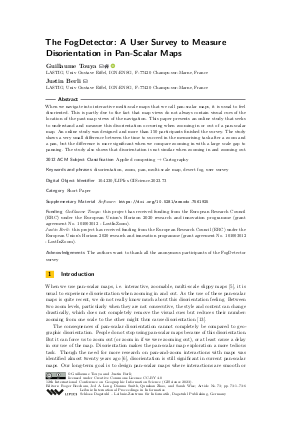LIPIcs.GIScience.2023.73.pdf
- Filesize: 1.61 MB
- 6 pages

 Creative Commons Attribution 4.0 International license
Creative Commons Attribution 4.0 International license

When we navigate into interactive multi-scale maps that we call pan-scalar maps, it is usual to feel disoriented. This is partly due to the fact that map views do not always contain visual cues of the location of the past map views of the navigation. This paper presents an online study that seeks to understand and measure this disorientation occurring when zooming in or out of a pan-scalar map. An online study was designed and more than 150 participants finished the survey. The study shows a very small difference between the time to succeed in the memorising task after a zoom and a pan, but the difference is more significant when we compare zooming in with a large scale gap to panning. The study also shows that disorientation is not similar when zooming in and zooming out.

Feedback for Dagstuhl Publishing